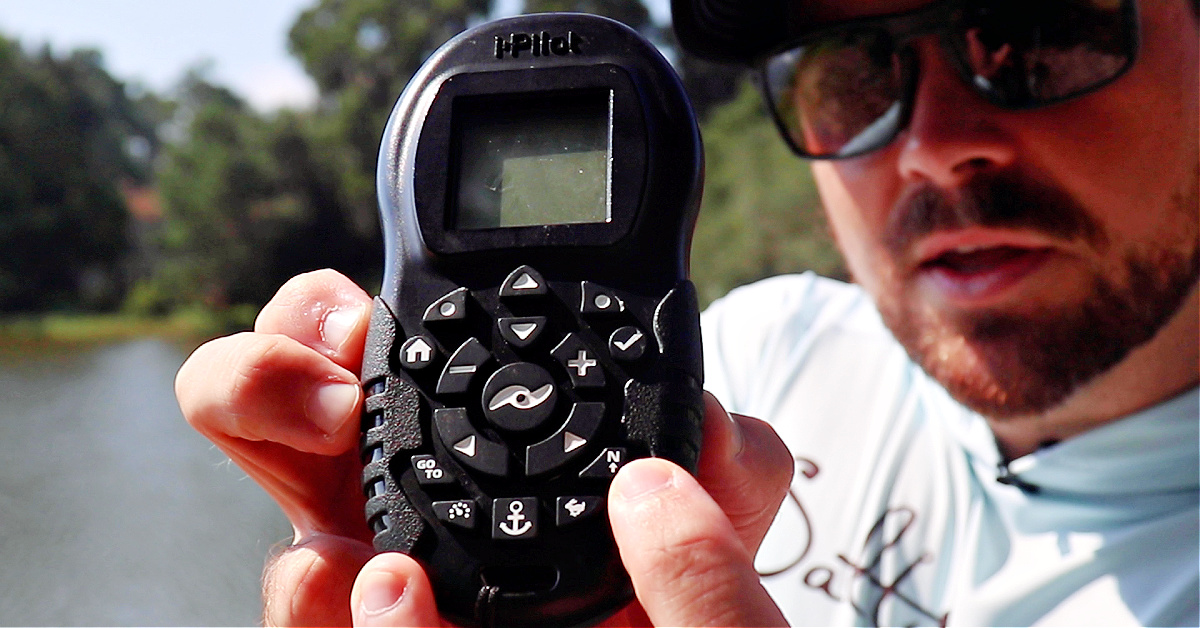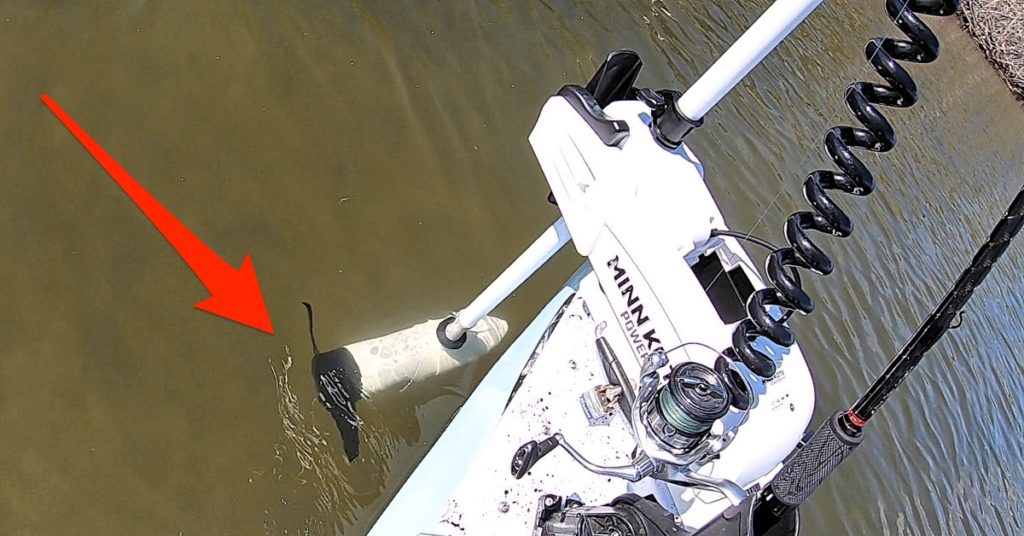Your Trolling Motor Is Spooking Fish. Here’s Why…
- By: Richard Thomas
- on

Are you aware that it’s possible your trolling motor is spooking fish?
This topic is not broken down a whole lot but it can mean the difference between a skunked day or fish in the boat.
If you find schools of fish or you are approaching a new area, it is critical that you take every step carefully so you can be more successful.
Take a look below!!
Your Trolling Motor Is Spooking Fish [VIDEO]

Setup Used In This Video:
- Fitzgerald Aqua Dream Series 7’6 Medium
- TFO Professional 7’6 Medium
- Slam Shady 2.0 Paddletail
- Gold Digger Paddletail
- Hoss Helix Hooks
Especially right now while its hot out, it is super important to avoid spooking fish.
In the fall and wintertime, fish tend to be a bit more hunkered down to the area they are holding in.
But in the summer, they will not stick around and more often than not they’ll go find somewhere else to feed.
Approaching A Spot
Anytime you are moving into a new area to fish, you want to do everything you can to be on the down current side.
There is two reasons for this.
The first is you are more stealthy because the vibrations your vessel gives off move with the current.
Most of the noise and vibration is carried away with the current.
And the second reason is you have more control over your vessel, especially if you are using a trolling motor.
You actually have more maneuverability left or right going against the current.
If you approach a spot with the current, the current will want to push you and your boat right into the fish.
Spotlock VS. Heading Lock Settings
Spotlock is a super useful feature to have but, in an inshore fishing setting, you do not want to use spotlock unless you absolutely have to.
This feature keeps you pinned on that GPS location.
If there is a wind change or the current switches direction, your trolling motor will automatically try to correct your vessel’s position.
You have no control at this point of the speed and sound the motor will give off.
That vibration and thrust does more than enough to completely spook out fish from an area.
On most trolling motor remotes, there is a little button with “N” for North with an arrow facing up.
This is the heading feature on trolling motors.
All you have to do is point the remote in the direction you want your motor to go and click.
This simply keeps you pointing towards a single direction.
But you can adjust your speed to stay in the position needed to almost “anchor” yourself to a spot.
Through this process, you are making micro-adjustments rather than having the motor drastically change direction and scare fish.
If you need to get closer to the fish, bump up the speed.
If you need to back off a little bit, slow down.
You will make a lot less noise and also maintain a constant position.
The Heading Lock feature is much more efficient than Spotlock and is easier to make adjustments with.
Conclusion

The last thing you want to do is get all the way to the perfect spot you found and its filled with fish only for your trolling motor to make noise and spook them out.
Using the methods discussed above will help you make smaller adjustments rather than those major adjustments that cause vibrations and noise that scare fish.
Do you have any additional questions about trolling motors in general?
Let me know if you use the Heading Lock feature and if you find it to be better than Spotlock!!
And, if you know someone who wants to learn more about why your trolling motor is spooking fish, please TAG or SHARE this with them!
Oh, and if you Join the Insider Club TODAY, Smart Fishing Spots is absolutely FREE! Click here to join us in the Insider Club!
Related Articles:
Related categories:
STOP WASTING TIME ON THE WATER!
Do what the “SMART ANGLERS” are doing and join the Insider Club.
Here’s what you’ll receive today when you join:
- Weekly fishing reports and TRENDS revealing exactly where you should fish every trip
- Weekly “spot dissection” videos that walk you through all the best spots in your area
- Exclusive fishing tips from the PROS you can’t find anywhere else
- Everything you need to start catching fish more consistently (regardless if you fish out of a boat, kayak, or land).










A great video. I ran across it while searching on “trolling”. Question: How did you find the school of trout?
BTW on my Humminbird Mega Live, while watching a school of baitfish, I actually saw the baitfish break up several times while using Spot Lock on a windy day. I’m almost sure the trolling motor was spooking the bait as it corrected for the bow moving left and right in the wind.
Keep these great videos coming!
Oh yea it’s very important on how you use your trolling motor when first approaching an area but I don’t have spotlick on my trolling motor just a minn Kota maximum riptide 55lb thrust hand held bow mount I have heard some bad storied about the new motors that use a remote like when and if it goes bad your pretty much screwed because the motor is useless without the remote no I like my old fashioned hand controlled one works great and has for years for me and dont plan on changing anytime soon but thanks for the advice and all you do😉
Definitely Steven! It’s got some advantages such as you being able to move around the boat freely, but if a battery goes out or something happens to the remote you’re going to have to fish the old fashioned way with a anchor!
ill use the directional for a slow drift into or out of a creek or a controlled troll
It’s a great feature for sure!
Great Point on the Trolling motor. I will try this the next time…
Absolutely James! It’s made a huge difference for me by just changing up those few things I mentioned. Let me know how it works for you!
Agree 100% on the spot lock. I wish it could be tweaked to be more “gentle”
Same, it can really be brutal even when you try and make it where the boat is almost stoped!
Richard/Dana … G-Force ELIMINATOR Trolling Motor Prop Nut Minn Kota: https://thmarinesupplies.com/products/g-force-eliminator-trolling-motor-prop-nut-minn-kota
Do either one of you think these prop nuts dampen sound? Any way to reliably test to prove or disprove their claims? Thanks
Two main sources of noise associated with trolling motors would logically be the motor noise at whatever frequency it spins (varies with speed) and the cavitation from the blades of the prop (would increase at higher speeds). I can’t see where this gadget would affect either.
Probably best to limit the speed at which you operate your trolling motor and concentrate on noise discipline within your boat (footsteps, radios blasting, etc.). Doing so is free and, I’m convinced, more effective.
An underwater recording device would be required for documented proof. However, logic and relying on recorded studies of sound in water steers me to the above conclusions.
Thanks, Dana! There is a video of a guy using an underwater recording device, and that device showed little difference using a G-Force Prop Nut. Some time ago, an Insider commented that a recording device would not accurately detect the noise . . . no explanation why. I discounted that view.
Hey guys, Can you put a spot lock motor on the stern of a small boat or kayak? Would it still work?
I doubt it would work…it is designed to pull the boat, not push it…and I don’t know how it could be mounted.
I’ve seen a few Mods on YouTube, but not really any I would recommend.
Good vid! Noise is definitely a major factor when fishing from a boat.
As an old Sonar Tech I figured I would give some input on the propagation of sound in water. Sound in water is affected by three main things: temperature, pressure and salinity. Currents have such a small effect on sound in water that it is not even factored in when determining propagation paths for hunting subs regardless of distances.
All that said, controlling the noise you make in a boat is very important, particularly inshore in shallower water where your proximity to the fish is usually pretty close.
Thanks again for all the great vids y’all do! Keep fishin’!
Hey Dana that’s good to know!!
I started approaching fish from the downstream/current side when I was fly fishing in mountain streams. You could sneak up on fish much easier, but looks like the main factor would be the fish are just facing away from you in the current. Great info thanks.
Richard, you’re welcome! The downstream approach also allows your lure/bait to approach the strike zone from the natural direction which of course helps in not spooking the fish. Of course, you guys all know that and you often mention it. So many factors enter into it.
Definitely is, and I’ve had much more success approaching from the down current side in general. Love hearing about the main factors of how sound/vibrations Travel in the water. Very cool!
I need to add a trolling motor to my boat…can I get some recommendations on brand and model and must have options?
The top 3 in the market are Minn Kota, Motor Guide and now Garmin also has one of their own.
We’ve done some extensive podcast on each one, there are a ton of things to consider!
I use minn Kota and I Believe Luke uses Motor Guide.
I have a minnkota terrova and so far it’s been a good motor. My boats a smaller skiff 17ft and the motors a 12v 55lbs thrust and it is plenty of power for what I use it for. Easy on the battery as long as you are not running around on high speed or bucking high winds all day and it’s tough I have run it over stumps and banged docks and piling with it and I run it shallow with no issues. I’am not known for being easy on the equipment Lol! Not to impressed with the spot lock, it works well it’s just too noisy shallow it works almost to well it runs constantly to hold your position.
Choose a brand you like (all of the top three are good), then spend as much as you are comfortable with.
More thrust = using less capacity – I run a 36 volt, 112 lb. thrust motor on an 18 1/2 foot boat, and seldom run it above 3.5 while I am fishing. Less noise, less motor capacity, and much longer battery life.
To add one more thing, just had a power pole installed. Complete game changer. I will never own another boat without one.
That’s definitely a next purchase item for me in the future. Glad to hear you like yours